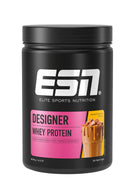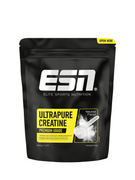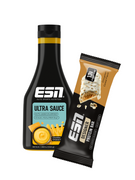Dennoch scheitern die meisten Trainierenden an der komplexen Herausforderung, was unterschiedliche Gründe hat, aber in erster Linie daran liegt, dass der Mensch bei emotional behafteten Themen dazu neigt, irrational zu agieren und den Verstand außen vor zu lassen. Ursächlich ist die schier nicht enden wollende Flut an speziellen Sixpack-Trainingsprogrammen, Ernährungsformen und angeblichen Shortcuts, mit deren Hilfe es möglich sein soll, mit dem geringstmöglichen Aufwand maximale Erfolge zu erzielen.
In der Realität bedarf es für den Aufbau eines ansehnlichen Waschbrettbauchs hingegen einer Kombination aus intelligentem Training, einer gesunden Ernährung und nicht zuletzt einer gesunden Portion Ehrgeiz und Disziplin. Wie das Projekt "Sixpack" in jedem Fall gelingt, zeigt der folgende Guide.
Was ist ein Sixpack?
Bevor wir unmittelbar in die Praxis einsteigen, sollte zu Anfang die Frage stehen, was ein Sixpack überhaupt ist und warum Athletinnen und Athleten so sehr danach lechzen. Der Name Sixpack bezeichnet eine spezielle Erscheinungsform des geraden Bauchmuskels, der durch massive Sehnenstränge in die namensgebenden "Packs" unterteilt wird. Diese Pakete ergeben das charakteristische Waschbrettmuster, das allerdings nur dann zutage tritt, wenn ein entsprechend niedriger Körperfettanteil vorhanden ist.

Da die genetische Ausprägung der Bauchmuskulatur ebenso wie die Verteilung des viszeralen und subkutanen Fettgewebes von Mensch zu Mensch durchaus variiert, lässt sich nicht allgemeingültig festhalten, ab welchem Körperfettanteil der Waschbrettbauch bei einem Individuum deutlich sichtbar wird. Gemeinhin lässt sich jedoch sagen, dass sich die Packs in ihrer typischen Form bei Männern ab ca. 12 Prozent Körperfett und bei Frauen ab rund 17 Prozent Körperfettanteil signifikant abzeichnen.
Im Angesicht der Tatsache, dass der Anteil des Fettgewebes, das die meisten Menschen heute mit sich herumtragen, deutlich zu hoch ist, liegt es schon aus rein praktischen Gründen auf der Hand, warum das Erreichen eines Sixpacks oder zumindest der Ansatz eines solchen unter Trainierenden derart hoch im Kurs steht.
Faszination Sixpack
Die Affinität zum Waschbrettbauch ist dem Mensch in die Wiege gelegt.
Auch wenn ein Großteil der Anziehungskraft des Sixpacks auf den in unserer Gesellschaft omnipräsenten Schönheitsidealen beruht, spielt auch die Schule der Evolution in diesem Zusammenhang eine nicht ganz unwichtige Rolle.
Als der Mensch in grauer Vorzeit noch als Jäger und Sammler durch die raue Natur Europas zog, herrschte noch das darwinistische Prinzip "survival of the fittest", was dem Wortsinn entsprechend als das "Überleben des Angepasstesten" übersetzt werden kann.
Folglich spielte im Rahmen der Partnerwahl vor allem die körperliche Kraft eines Individuums eine tragende Rolle, da nur starke Individuen dazu in der Lage waren, ihren Nachwuchs zu schützen und die Sippe zu ernähren. Ebenso wie breite Schultern und eine massive Brustmuskulatur galt auch das wohldefinierte Sixpack als Zeichen der Vitalität, da unter anderem der damit verbundene geringe Körperfettanteil, Agilität und somit Überlebensfähigkeit ausstrahlte.
Da in evolutionärer Hinsicht seit der Zeit des Neolithikums nur wenige Augenblicke vergangen sind, wohnt die magische Anziehungskraft des Waschbrettbauchs auch dem modernen Menschen noch inne. Bedingt durch die mit dem Erreichen eines Sixpacks verknüpften Mühen, werden Menschen, die ein solches vorzuweisen haben, Eigenschaften wie Disziplin und Zielstrebigkeit zugeschrieben, was sowohl auf Männer als auch auf Frauen äußerst attraktiv wirkt.
Anatomische Grundlagen der Bauchmuskulatur
Dass die Begrifflichkeit des Sixpacks nicht immer zu einhundert Prozent zutreffend ist, merken wir spätestens dann, wenn wir uns im Sommer einmal am Strand umblicken und dort scheinbar völlig unterschiedliche Ausprägungen zu Gesicht bekommen, die in erster Linie nichts mit dem Körperfettanteil zu tun haben.
Ursächlich ist auch hier wieder die Genetik des Menschen, die nicht nur darüber entscheidet, wie ausgeprägt die Bauchmuskulatur an sich ist, sondern auch darüber wie viele Sehnenstränge den geraden Bauchmuskel (musculus rectus abdominis) in die charakteristischen Packs unterteilen. Die von Mensch zu Mensch unterschiedlichen Sehnenmuster führen also dazu, dass ein Athlet zwischen vier und acht "Packs" haben kann.
Darüber hinaus entspricht der Verlauf der Sehnenstränge entgegen den idealisierten Hochglanzcovern diverser Magazine nicht immer einer symmetrischen Form, sodass durchaus leichte Verschiebungen der einzelnen Packs möglich sind.
Ein ansehnlicher Waschbrettbauch definiert sich jedoch nicht ausschließlich durch einen ausgeprägten geraden Bauchmuskel, denn insbesondere die schräge Bauchmuskulatur, die sich aus dem Musculus obliquus externus abdominis, dem Musculus obliquus internus abdominis sowie dem Musculus transversus abdominis zusammensetzt, trägt erheblich zum Gesamterscheinungsbild bei.
Allerdings ist der vordere Bauchmuskel nicht nur da, um schön auszusehen und vom jeweils anderen Geschlecht bewundert zu werden. Vielmehr ist die Bauchmuskulatur im Alltag in annähernd jeden Bewegungsablauf eingebunden, da sie im Zusammenspiel mit der Muskulatur des unteren Rückens ein zentrales Stützkorsett bildet. Darüber hinaus ermöglicht der Musculus rectus abdominis nicht nur das Beugen des Rumpfes sowie das kraftvolle Anheben des Beckens, sondern dient auch dem Schutz der inneren Organe vor äußeren Einflüssen.
Beliebte Fehler beim Bauchmuskeltraining
Trotz ihrer exponierten Stellung als Stützmuskulatur unterscheidet sich die Bauchmuskulatur hinsichtlich der Muskelfaserzusammensetzung nicht sonderlich von der übrigen Skelettmuskulatur. Umso unverständlicher ist es, das sich in Anbetracht dieser Tatsache noch immer unzählige Trainingsmythen halten, die dazu führen, dass viele Athleten ihr Ziel nicht erreichen.
Bevor es also daran gehen kann, einen korrekten Trainingsplan samt Ernährungsplan aufzustellen, lohnt sich ein Blick darauf, welche Fehler in jedem Fall zu vermeiden sind. Der mit Abstand am häufigsten begangene Fehler ist dementsprechend die fälschliche Annahme, dass es sich bei der Bauchmuskulatur gemäß ihrer Muskelfaserzusammensetzung um "Ausdauermuskeln" handelt. In der Folge neigen viele Athleten dazu, ihren Bauch vier- bis fünfmal pro Woche oder gar jeden Tag mit unzähligen Wiederholungen zu malträtieren.
Dies hat langfristig lediglich eine Stagnation zur Folge, da es der Muskulatur gar nicht mehr möglich ist, sich adäquat zu regenerieren und schon gar nicht zusätzliche Masse aufzubauen. Grundsätzlich kann es in Abhängigkeit zu den genetischen Voraussetzungen eines Trainierenden durchaus vorkommen, dass sich die Bauchmuskulatur aus überdurchschnittlich vielen langsam kontrahierenden Muskelfasern des Typs-I zusammensetzt, was den Muskel jedoch nicht zu einem Ausdauermuskel macht.

Folglich benötigt der Bauch keine trainingstechnische Sonderbehandlung, sondern kann wie jeder andere Muskel trainiert werden. Mindestens so wichtig wie der Trainingsumfang samt angepasster Trainingsintensität ist zudem die Übungsauswahl, da es sich bei der Bauchmuskulatur um ein relativ komplexes Gebilde handelt, das im Gegensatz zum Bizeps nicht nur mit einer einzigen Aufgabe betraut ist. Es leuchtet also ein, dass es nicht gerade zielführend ist, das Bauchtraining ausschließlich auf Crunches oder Sit-ups zu beschränken. Ein guter Trainingsplan sollte indes in jedem Fall die unterschiedlichen Aufgaben der Bauchmuskulatur sowie die damit verbundenen Belastungsmuster berücksichtigen, um optimale Ergebnisse zu erzielen. In der Praxis empfiehlt es sich also, den geraden Bauchmuskel sowohl aktiv als auch passiv zu trainieren.
Die Bauchmuskeln passiv trainieren
Das passive Training zielt in erster Linie darauf ab, die Bauchmuskulatur entsprechend ihrer Stützfunktion zu trainieren, was im Kreise der Fitnessgemeinde in der Vergangenheit jedoch auch zu einigen Kontroversen führte. Diesbezüglich kursiert leider noch immer der Mythos, dass es ausreicht, passiv zu trainieren, um ein Sixpack zu bekommen, und dass das aktive Training der Bauchmuskulatur demzufolge nicht notwendig wäre.
Auch wenn diese Aussage in keinster Weise der Realität entspricht, ist das passive Training ein essenzieller Baustein, der nur allzu häufig vernachlässigt wird. Dies trifft hauptsächlich auf Freizeitsportler zu, die vorrangig an Maschinen trainieren und schwere Grundübungen meiden.
Dabei sind eben diese Grundübungen eine hervorragende Möglichkeit, um die Bauchmuskulatur passiv zu trainieren, da sie sowohl beim Kreuzheben als auch beim Kniebeugen erhebliche Stützarbeit leisten muss. In der Folge werden beim passiven Training somit primär die ausdauernden Typ-I-Muskelfasern trainiert. Im Gegenzug legt das aktive Training seinen Fokus auf die schnell kontrahierenden Muskelfasern des Typs-IIb sowie auf die intermediären Muskelfasern des Typs-IIa/c.
Da sich die Muskelfaserzusammensetzung im Verhältnis zueinander bei jedem Menschen ein wenig unterscheidet, ist es umso wichtiger, alle drei Muskelfasertypen im Rahmen des Trainings zu berücksichtigen, um bestmögliche Ergebnisse vorweisen zu können.
Aktives Bauchmuskeltraining
Das, was die meisten Freizeitsportler unter Bauchtraining verstehen, ist in der Sportwissenschaft unter der Bezeichnung "aktives Bauchtraining" bekannt und folgt dem Muster des klassischen Hypertrophietrainings, wie es auch für jede andere Muskelgruppe praktiziert wird.
Aufgrund der Tatsache, dass es sich beim geraden Bauchmuskel um einen auf seine Fläche bezogen recht großen Muskel handelt, der im Rahmen des passiven Trainings jedoch bereits stark belastet wird, reicht es aus, das aktive Training auf zwei bis maximal drei Übungen pro Einheit zu beschränken.
Im Fokus sollte diesbezüglich die Intensität des Trainings stehen, da nur auf diese Weise entsprechende Wachstumsreize gesetzt werden können. Wer drei halbherzige Sätze Bizepscurls mit viel zu wenig Gewicht und mehr Schwung als Technik ausführt, erwartet schließlich auch keine Wachstumsexplosion.
Es ist also völlig klar, dass die Qualität der einzelnen Wiederholung das Zünglein an der Waage ist. Die Ausführung im Rahmen der jeweils acht bis zwölf Wiederholungen umfassenden Sätze sollte folglich langsam und kontrolliert erfolgen, um möglichst viele Muskelfasern rekrutieren zu können, die den Workload übernehmen. Im Bezug auf die Übungen herrscht überraschenderweise leider noch immer die Ansicht, dass Crunches das Allheilmittel für den Waschbrettbauch sind.
Sportwissenschaftliche Studien konnten jedoch belegen, dass Crunches aufgrund des geringen Bewegungsradius (Range of Motion) deutlich weniger effektiv sind als vergleichbare Übungen. Nicht zuletzt deshalb ist es ratsam auf ein Repertoire von unterschiedlichsten Übungen zurückzugreifen, wodurch zudem gewährleistet ist, dass sich die Muskulatur nicht zu schnell an die Belastung adaptiert.
Zudem empfiehlt es sich, wann immer möglich, auf Zusatzgewichte zurückzugreifen, um das Training intensiver zu gestalten. Auch ermöglicht die Verwendung von Zusatzgewichten beispielsweise in Form von Hantelscheiben oder Gewichtsmanschetten, die stetige Steigerung der Trainingsbelastung über Wochen, Monate und Jahre hinweg, sodass ein kontinuierlicher Fortschritt gewährleistet ist.
Sixpack-Workouts in der Praxis
Der optimale Trainingsplan für ein Sixpack setzt sich also gleichermaßen aus passiven als auch aus aktiven Belastungen zusammen, die im besten Fall ein ansehnliches Gesamtergebnis erzeugen.
In der Trainingspraxis ist ergo darauf zu achten, dass eine ausreichende Anzahl an Grundübungen ausgeführt wird, welche die Basis für das zwei- bis dreimal wöchentlich zu empfehlende Bauch-Workout darstellen. Wer sich hingegen ausschließlich auf das Training an Maschinen sowie auf Isolationsübungen beschränkt, entfernt sich ein Stück weit von seinem Ziel.
Das folgende Beispiel soll erläutern, wie ein Sixpack-Workout in einen klassischen 2er-Split nach dem Muster Push-Pull integriert werden kann.
Während am Push-Tag die Kniebeuge größere Aufmerksamkeit erfahren sollte, ist am darauf folgenden Pull-Tag darauf zu achten, dass Kreuzheben korrekt ausgeführt wird.
Besonders effektiv für die Bauchmuskulatur ist insbesondere die Frontkniebeuge, da sich der Schwerpunkt deutlich nach vorne verlagert, was die Bauchmuskulatur verstärkt unter Spannung setzt. Im Anschluss an die Grundübungen, die den passiven Teil des Bauchtrainings bilden, folgt das aktive Training im Zuge der Ausführung von Cable-Crunches, Sit-ups mit Zusatzgewicht, Beinheben am Holm oder unter Zuhilfenahme diverser Bauchmaschinen.

Von der umgekehrten Reihenfolge ist dringend abzuraten, da die vorermüdete Bauchmuskulatur die Leistungsfähigkeit im Rahmen der Grundübungen deutlich herabsetzt und zudem das Risiko für schwerwiegende Verletzungen erhöht. Die für das Muskelwachstum essenzielle Intensität kann durch das bewusste Anspannen der Bauchmuskulatur am Ende der konzentrischen Bewegungsphase zusätzlich optimiert werden.
Ganz gleich, welche Übung letztlich ausgewählt wird, muss zwingend darauf geachtet werden, dass die Satzpausen nicht zu lange dauern, da das für das Bauchtraining extrem wichtige Muskelgefühl aufgrund der Erkaltung der Muskulatur ansonsten großteilig verloren geht. Folgerichtig empfehlen sich Pausen von 60 bis maximal 90 Sekunden.
Weitere effektive Übungen für die Bauchmuskulatur:
- Sit-up / Stand-up
- Rollouts mit der Langhantel
- Bergsteiger
- Side Plank
- Reverser Crunch
- Unterarmstütz
Die Ernährung als wichtiger Sixpack-Faktor
Abs are made in the kitchen!
Auch wenn die Bedeutung des Trainings für den Aufbau eines Waschbrettbauchs nicht hoch genug einzuschätzen ist, so ist es letztendlich doch die Ernährung, die darüber entscheidet, ob sich all die Mühen auszahlen. Der englische Satz "Abs are made in the kitchen", zu Deutsch, "Bauchmuskeln werden in der Küche gemacht", ist also durchaus zutreffend.
Ursächlich ist der eingangs erwähnte unumstößliche Fakt, dass sich die Bauchmuskulatur erst bei einem niedrigen Körperfettanteil (Kfa) abzuzeichnen beginnt. Bei einem hohen Kfa hingegen bleiben diese verborgen. Wenn sich der prozentuale Körperfettanteil eines Trainierenden also nicht bereits ohnehin in einem relativ niedrigen Bereich befindet, ist zunächst einmal der Fettabbau angesagt, der lediglich über ein Energiedefizit zu erreichen ist.
Dieses Energiedefizit darf jedoch nicht zu groß ausfallen, da sich der Stoffwechsel ansonsten evolutionsbedingt auf eine scheinbare Hungerphase einstellt und seine Aktivität dementsprechend reduziert, was den Organismus mittelfristig aus seinem Gleichgewicht bringt, aktive Muskelmasse verzehrt und das Auftreten des Jojo-Effekts fördert. In Zahlen bedeutet dies, dass nicht mehr als maximal ein halbes Kilogramm Fettverlust pro Woche angestrebt werden sollte, sodass unter dem Strich ein tägliches Energiedefizit von rund 500 Kilokalorien steht.
Dieses Defizit kann sowohl durch eine Reduktion der Nährstoffzufuhr als auch unter Zuhilfenahme von Ausdauertraining erfolgen. Letzteres ist zum Erreichen eines Waschbrettbauchs zwar nicht zwingend notwendig, der allgemeinen Fitness jedoch äußerst zuträglich.
Darüber hinaus ist es für viele Sportler sowohl aus physischer als auch aus psychologischer Sicht deutlich einfacher, den täglichen Kalorienverbauch zu erhöhen, anstatt die Nahrungszufuhr einzuschränken. Um den eigenen Energiebedarf näherungsweise auszurechnen, genügt die Faustformel: Körpergewicht in KG x 24 x individueller Leistungsumsatz (PAL-Wert*).
Der sich daraus ergebende Wert stellt den durchschnittlichen Tagesbedarf in Kilokalorien dar und muss dementsprechend durch zusätzlichen Ausdauersport oder die Nahrungsverknappung um die angesprochenen 500 Kilokalorien pro Tag reduziert werden, um einen gleichmäßigen Fettabbau zu erreichen.
PAL-Übersicht*:
- PAL-Wert 1,2: überwiegend liegende oder sitzende Lebensweise (Rollstuhlfahrer, bettlägerige Menschen etc.)
- PAL-Wert 1,3-1,5: überwiegend sitzende Tätigkeit mit wenig Aktivität (Lehrer, Büroangestellte, Studenten etc.)
- PAL-Wert 1,6-1,7: teilweise stehende oder gehende Berufstätigkeit (Laboranten, Fließbandarbeiter etc.)
- PAL-Wert 1,8-1,9: primär stehende oder gehende Tätigkeit (Kellner, Handwerker etc.)
- PAL-Wert 2,0-2,4: harte körperliche Berufstätigkeit (Landwirte, Bauarbeiter etc.)
Sixpack-Ernährung in der Praxis
Da es nicht immer einfach ist, den Überblick über die aufgenommenen Nährstoffe zu wahren, ist es empfehlenswert zumindest einen groben Ernährungsplan zu formulieren, der ebenfalls eine prozentuale Nährstoffverteilung beinhaltet.
Im Fokus dieser Nährstoffverteilung steht vorrangig das Protein, das insbesondere im Rahmen einer Diät in ausreichendem Maße zugeführt werden muss, um den Abbau von stoffwechselaktiver Muskelmasse zu verhindern. Die Grundlage für die Bestimmung einer angemessenen Proteinzufuhr ist abermals das Körpergewicht eines Athleten, das mit dem Faktor 2 multipliziert den minimalen Proteinbedarf in Gramm pro Tag ergibt.
Der Ernährungsplan eines 80 Kilogramm schweren Mannes würde dementsprechend einen täglichen Eiweißbedarf von 160 Gramm aufweisen. Ähnlich verhält es sich im Bezug auf den Fettkonsum, der in vielen Sixpack-Ratgebern verteufelt wird. Vielmehr ist es jedoch so, dass der Organismus auf den essenziellen Nährstoff Fett angewiesen ist, da dieser an unzähligen Stoffwechselvorgängen beteiligt ist.
Kommt es zu einer dauerhaften Verknappung der Verfügbarkeit von Fett, neigt der Organismus dazu, zunehmend an seinen Fettdepots festzuhalten. Daraus folgt, dass sich der Konsum von Fetten, insbesondere der von hochwertigen Omega 3 und 6 Fettsäuren, auf einem angemessenen Niveau befinden muss. In der Sportwissenschaft geht man diesbezüglich von 0,8 - 1,0 Gramm pro Kilogramm Körpergewicht und Tag aus.
Um den verbleibenden Teil des Energiebedarfs zu decken verbleiben die Kohlenhydrate, die vorwiegend komplexer Natur sein und hochwertigen Quellen entstammen sollten. Mitunter entspricht der daraus resultierende moderate Kohlenhydratkonsum einem gemäßigten Low-carb-Prinzip, das in seiner Ausprägung dem natürlichen Ernährungsverhalten des Menschen sehr nahe kommt.
Überdies gewährleistet die gemäßigte Kohlenhydratzufuhr, dass dem Körper für das kraftraubende Training ausreichend Energie zur Verfügung steht. Um unerwünschte Insulinpeaks zu vermeiden, sollten die Kohlenhydrate ebenso wie die Gesamtnahrungsmenge auf fünf Mahlzeiten aufgeteilt werden, sodass eventuellen Heißhungerattacken effektiv vorgebeugt werden kann und der Organismus darüber hinaus über den gesamten Tag hinweg gleichmäßig mit Makronährstoffen versorgt ist. Dass auch ausreichende Mengen Obst und Gemüse für die Mikronährstoffzufuhr auf dem Speiseplan stehen sollten, bedarf hoffentlich keiner weiteren Erläuterung.
Zugegebenermaßen ist es nicht immer einfach, die auf dem Ernährungsplan vermerkten Makronährstoffmengen aufzunehmen, sodass es durchaus hilfreich sein kann, Nahrungsergänzungsmittel einzusetzen. Dies betrifft in erster Linie Proteinpulver sowie Präparate, die gesunde Omega 3 und 6 Fettsäuren liefern.
Nahrungsergänzungen für den letzten Schliff
Erwiesenermaßen äußerst hilfreich können auch Stimulanzien sein, die sich positiv sowohl auf die körperliche als auch auf die kognitive Leistungsfähigkeit auswirken. In erster Linie betrifft dies Koffein und Guarana, die das zentrale Nervensystem anregen und vor dem Hintergrund des im Zuge einer Diät auftretenden Energiemangels für einen kleinen Leistungsschub sorgen können, wodurch sich das unter vielen Trainierenden unbeliebte Bauchtraining auch an schlechten Tagen deutlich besser absolvieren lässt.
Darüber hinaus erhöhen Koffein- und Guaranapräparate nachweislich die Stoffwechselrate, sodass der Kalorienverbrauch etwas ansteigt und somit auch mehr Fett verbrannt werden kann. In diesem Zusammenhang sei allerdings erwähnt, dass es keine Wundermittel gibt, mit den es auf legale Weise möglich wäre, das Körperfett wie von Zauberhand schmelzen zu lassen. Folgerichtig stellen Nahrungsergänzungsmittel lediglich einen ergänzenden Baustein des Projekts "Sixpack" dar und taugen keinesfalls als Ersatz für einen guten Trainings- und Ernährungsplan sowie für eine gehörige Portion Disziplin.
Wer bei seinem persönlichen Projekt bestrebt ist, die letzten Leistungsprozente mittels Supplements aus seinem Körper heraus zu kitzeln, sollte diese Produkte allerdings ausschließlich bei vertrauenswürdigen Händlern erwerben, um gesundheitsgefährdenden illegalen Substanzen aus dem Weg zu gehen.








